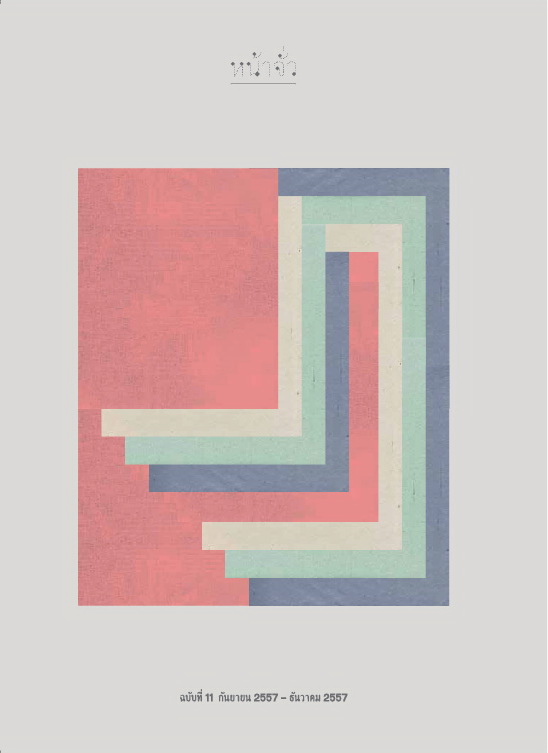โขง ระหว่างพุทธศตวรรษที่ 21–25 รูปแบบ เทคนิค และแนวคิดของกลุ่มสกุลช่างลำปาง/ A Study of Patterns and Concepts’s Lampang Torana
Main Article Content
Abstract
บทคัดย่อ
การวิจัยเรื่อง “การศึกษารูปแบบและแนวคิด ซุ้มประตูโขงและโขงพระเจ้า สกุลช่างลำปาง ระหว่างพุทธศตวรรษที่ 21–25” มีวัตถุประสงค์เพื่อเก็บรวบรวมรูปแบบและลักษณะของซุ้มประตูโขงและกู่โขงพระเจ้า เพื่อจำแนกประเภท อายุสมัย และรูปแบบ อันเป็นเอกลักษณ์ของสกุลช่างลำปาง และนำมาวิเคราะห์การเปลี่ยนแปลง ทั้งด้านคติความเชื่อ เทคนิคการตกแต่ง รวมถึงลักษณะของซุ้มประตูโขงที่เปลี่ยนไป ลักษณะการวิจัยเป็นเชิงคุณภาพ โดยการสำรวจลงพื้นที่ซึ่งมีวิธีการศึกษาในเชิงปฏิบัติการร่วมกับคนในชุมชน ทั้งการสอบถามรายละเอียดสัมภาษณ์และการสนทนากลุ่ม พร้อมทั้งทำการสำรวจรังวัดสัดส่วนทางสถาปัตยกรรม บันทึกภาพรายละเอียดต่างๆ แล้วนำข้อมูลที่ได้มาวิเคราะห์ช่วงอายุ กลุ่มช่าง และเทคนิคการสร้าง
ผลการศึกษาพบว่าสามารถจำแนกประเภท อายุสมัย รูปแบบและลักษณะของซุ้มประตูโขงและโขงพระเจ้าอันเป็นเอกลักษณ์ของสกุลช่างลำปางในเขตพื้นที่จังหวัดลำปางได้ทั้งหมด 26 ตัวแบบจากแหล่งมรดกทางวัฒนธรรม 17 แหล่ง ซึ่งข้อมูลดังกล่าวสามารถนำไปใช้ในการสร้างและอนุรักษ์ รวมถึงผลักดันซุ้มประตูโขงและโขงพระเจ้าให้เป็นมรดกทางวัฒนธรรมท้องถิ่นในอนาคตได้
ทั้งนี้หน่วยงานที่มีส่วนเกี่ยวข้องควรเข้าไปให้ความรู้ความเข้าใจในการอนุรักษ์รักษางานศิลปกรรมดังกล่าว โดยชี้ให้ชุมชนเห็นคุณค่าและความสำคัญ เพื่อเป็นการปลุกจิตสำนึกรักและหวงแหนมรดกทางวัฒนธรรมของชุมชนตน ซึ่งในอนาคตชุมชนอาจจะเสนอขอขึ้นทะเบียนเป็นโบราณสถานและเป็นแหล่งมรดกทางวัฒนธรรม โดยชุมชนสามารถนำองค์ความรู้ที่ได้จากการวิจัยเป็นฐานข้อมูลเพื่อนำไปสู่การบริหารจัดการต่อไปได้ในอนาคต
Abstract
The study of “Patterns and Concepts of Lampang Torana”, or Lampang craftsmen school's Sum Pratu Khong (temple arch entrance) and Khong Phra Chao (Buddhist shrine), in 22-25 B.E. aims to collect patterns and characteristics of Sum Pratu Khong and Khong Phra Chao, and to categorize types, ages as well as dominant features of Lampang craftsmen school's Sum Pratu Khong and Khong Phra Chao. This study analyses its changes on belief, techniques and characteristics which has been changed through times. Methods of this quantitative study include field trips observation, participatory workshops and interviews with local people, group discussions, and architectural measurements on the Sum Pratu Khong and Khong Phra Chao in order to analyse ages, craftsmanship, and construction techniques.
The study finds that there are 26 patterns of Sum Pratu Khong and Khong Phra Chao in 17 cultural heritage sites in Lampang. This finding helps in identifying category and specific age to fit in 22-25 Buddhist era construction. Dominant features and patterns of Sum Pratu Khong and Khong Phra Chao in this study are also recorded as distinctive characteristics of Lampang craftsmen school. Changes in construction details assumed to be the result of changes on beliefs is also proven correct. It is certain that results found in the study could be used to preserve and conserve this cultural heritage.
Suggestions are that local and national cultural units and other related organizations should take the role in educating and establishing better understandings on the conservation of local, high-valued architecture. The result found in this study could give voice to local communities to request their own local heritage to be registered as national heritage.

